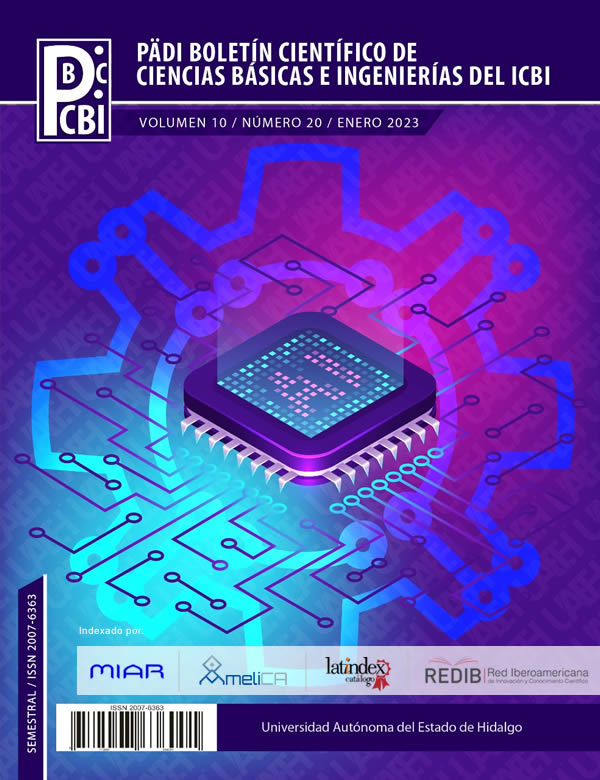Antifungal activity of mamey residues against Alternaria spp
Abstract
Fungi are the cause of entire crop devastation and agrochemicals are the main method of control. The use of plant extracts with antifungal activity is an alternative to reduce the use of chemical products. Mamey fruit residue extracts were evaluated in the development of Alternaria spp. Ethanol extracts of mamey fruit residues were prepared in a 1:5 (w/v) ratio, stirred for 72 hours, filtered and concentrated on a rotary evaporator. The concentrate was diluted in ethanol (1 mL) and mixed with PDA to a final concentration of 5 g L-1. The antifungal effect of the medium was determined through measurements of the diameter of fungal growth. The treatments showed 6.95, 18.65 and 46.43% inhibition for almond, almond and pericarp husk flour, respectively. The use of ethanolic extracts of mamey pericarp flour is an option for the non-chemical control of phytopathogenic fungi such as Alternaria spp.
Downloads
References
Ahmed, R., Sani, A., and Igunnugbemi, O., (2009). Antifungal profiles of extracts of Vitellaria paradoxa (Shea-Butter) bark. Ethnobotanical Leaflets 13, pp. 679-88.
Al Aboody, Mohammed S., and Suresh Mickymaray. (2020) Anti-Fungal Efficacy and Mechanisms of Flavonoids" Antibiotics 9(2), pp. 1-42.
Carballeira, N. M. (2008). New advances in fatty acids as antimalarial, antimycobacterial and antifungal agents. Progress in Lipid Research 47(1), pp. 50-61.
Baky, M. H., Kamal, A. M., Elgindi, M. R., & Haggag, E. G. (2016). A review on phenolic compounds from family Sapotaceae. Journal of Pharmacognosy and Phytochemistry 5(2), pp. 280-287.
Bautista-Baños, S., Hernández-López, M., and Barrera Necha, L. L., (2000). Antifungal Screening of Plants of the State of Morelos, Mexico Against Four Fungal Postharvest Pathogens of Fruits and Vegetables. Revista Mexicana de Fitopatología 18(1), pp. 36- 41.
Boleti, Ana Paula de A., Maria das Graças M. Freire, Mirela B. Coelho, Walciane da Silva, Paulo A. Baldasso, Valdirene M. Gomes, Sérgio Marangoni, José C. Novello, and Maria Lígia R. Macedo. (2007). Insecticidal and Antifungal Activity of a Protein from Pouteria torta Seeds with Lectin-like Properties. Journal of Agricultural and Food Chemistry 55(7), pp. 2653-2658.
Chandrasekaran, M., Senthilkumar, A., and Venkatesalu, V., (2011). Antibacterial and antifungal efficacy of fatty acid methyl esters from the leaves of Sesuvium portulacastrum L. European Review for Medical and Pharmacological Sciences 15(7), pp. 775-780.
Ertürk, Ö., (2006). Antibacterial and antifungal activity of ethanolic extracts from eleven spice plants. Biologia 61, pp. 275–278.
Korsten, L, and Jager EE., (1995). Mode of action of Bacillus subtilis for control of avocado postharvest pathogens. SAAGA Yearbook 18: pp. 124-130.
Kuc, J., (1992). Antifungal compounds from plants. In: Nigg, H.N., Seigler, D. (Ed.), Phytochemical resources for medicine and agriculture, Springer, Boston, MA., pp. 159-184.
Kuyu, C., (2015). Review on Potential Use of Fruit and Vegetables By-Products as A Valuable Source of Natural Food Additives. IISTE-Food Science and Quality Managemen 45., pp. 47-61.
Lee, H. S., & Kim, Y. (2022). Myricetin Disturbs the Cell Wall Integrity and Increases the Membrane Permeability of Candida albicans. Journal of Microbiology and Biotechnology 32, pp. 37-45.
Mahlo, S. M., McGaw, L.J. and Eloff, J.N., (2010). Antifungal activity of leaf extracts from South African trees against plant pathogens, Crop Protection 29(12), pp. 1529-1533.
Moo-Huchin, V., Estrada-Mota, I., Estrada-León, R., Cuevas-Glory, L. F. and Sauri-Duch, E., (2013). Chemical composition of crude oil from the seeds of pumpkin (Cucurbita spp.) and mamey sapota (Pouteria sapota Jacq.) grown in Yucatan, Mexico, CyTA-Journal of Food 11(4), pp 324-327.
Nava-Cruz, Y., and Ricker, M., (2005). Mamey Zapote [Pouteria sapota (Jacq.) H.E. Moore & Stearn], A Mexican Forest Fruit of High Commercial Value. In: Alexiades, M. N., and Shanley, P. (Ed.), Forest Products, Livelihoods and Conservation, Case Studies of Non-Timber Forest Product Systems, SMK Grafika Desa Putera, Indonesia, Ch. 3, pp. 43-61.
Pavón-Moreno, M. Á., González-Alonso, I., Martin de Santos, S, R. and Garcia Lacarra, T., (2012). Importancia del género Alternaria como productor de micotoxinas y agente causal de enfermedades humanas. Nutrición Hospitalaria 27(6), pp. 1772-1781.
Petriacq, P., López, A., and Luna, E., (2018). Fruit decay to disea¬ses: Can Induced Resistance and Priming Help?. Plants 7(4)., pp. 1-16.
Solís-Fuentes, J. A., Ayala-Tirado, R. C., Fernández-Suárez, A. D., and Durán-de-Bazúa, M. C. (2015). Mamey sapote seed oil (Pouteria sapota). Potential, composition, fractionation and thermal behavior. Grasas y aceites 66(11), pp. 1 – 10.
Souza-Moreira, T. M., Severi, J. A., Rodrigues, E. R., de Paula, M. I., Freitas, J. A., Vilegas, W., and Pietro, R. C., (2019). Flavonoids from Plinia cauliflora (Mart.) Kausel (Myrtaceae) with antifungal activity. Natural product research 33(17), pp. 2579-2582.
Tapwal, A., Garg, S., Gautam, N., and Kumar, R. (2011). In vitro antifungal potency of plant extracts against five phytopathogens. Brazilian archives of biology and technology 54(6), pp. 1093-1098.
Torres-Rodríguez, A., Salinas-Moreno, Y., Valle-Guadarrama, S., and Alia-Tejacal, I. (2011). Soluble phenols and antioxidant activity in mamey sapote (Pouteria sapota) fruits in postharvest. Food Research International 44(7), pp. 1956-1961.
Trigos, A., Ramírez, K., and Salinas, A., (2008). Presencia de hon¬gos fitopatógenos en frutas y hortalizas y su relación en la seguridad alimentaria. Revista Mexicana de Mi¬cología 28., pp.125-129.
Yahia, E., and Guttierrez-Orozco, F., (2011). Mamey sapote (Pouteria sapota Jacq. H. E. Moore & Stearn). In: Elhadi M. Yahia (Ed.), Postharvest biology and technology of tropical and subtropical fruits. Volume 3. Cocona to mango. Woodhead Publishing, England, Ch. 21, pp. 482-491.
Yamaji, B. K. and Ichihara Y., (2012). The role of catechin and epicatechin in chemical defense against damping-off fungi of current-year Fagus crenata seedlings in natural forest. Forest Pathology 42, pp. 1-7.













